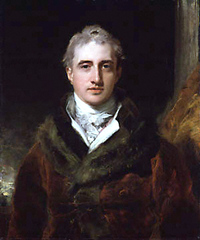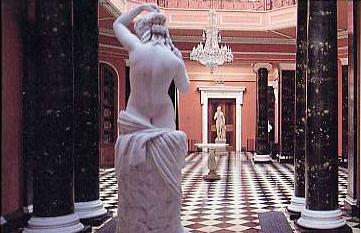(1769
- 1822)
Viscount Castlereagh was born in Dublin the
son of an Irish landowner (see Mount
Stewart Co Down) In 1790 he became a member of the Irish Parliament
and the British Parliament in 1794. Downpatrick was a"Rotten
Borough" which was bought for him by his father. These elections
could be bought for as much as thirty thousand pounds a vast sum
in those days.  The
Rotten Boroughs were abolished comparatively recently. In 1796 when
his father was created Earl of Londonderry he received the courtesy
title of Viscount Castlereagh. He played a large part in formulating
the peace settlements after the Napoleonic Wars in 1815. The
Rotten Boroughs were abolished comparatively recently. In 1796 when
his father was created Earl of Londonderry he received the courtesy
title of Viscount Castlereagh. He played a large part in formulating
the peace settlements after the Napoleonic Wars in 1815.
Possibly as a result of seeing the outcome
of the French revolution and also the American war of Independence
Castlereagh was instrumental in persuading the Irish parliament
to pass the Act of Union between Ireland and Britain. He took his
seat in the united House of Commons in 1801. Although Castlereagh
advocated freedom for Roman Catholics his family played a leading
role in suppressing with some ferocity the 1798 Rebellion of the
United Irishmen,
which enjoyed much Protestant support, indeed many of its leaders were Protestant.
indeed many of its leaders were Protestant.
Prime Minister William Pitt appointed Castlereagh
war minister in 1805. Castlereagh planned and implemented the overseas
operations against France. In 1809 he organized an unsuccessful
expedition against the island of Walcheren. Fellow Member of Parliament
George Canning vehemently opposed the expedition and as a result
of this difference of opinion the two fought a duel. Subsequently
both men resigned.
Castlereagh was appointed foreign secretary
and leader of the house in 1812. He used his considerable diplomatic
powers and social position to unite the enemies of Napoleon, and
after the battle of Waterloo (1815) to obtain favorable peace terms
for France and the reshaping of the European alliances. |

 The
Rotten Boroughs were abolished comparatively recently. In 1796 when
his father was created Earl of Londonderry he received the courtesy
title of Viscount Castlereagh. He played a large part in formulating
the peace settlements after the Napoleonic Wars in 1815.
The
Rotten Boroughs were abolished comparatively recently. In 1796 when
his father was created Earl of Londonderry he received the courtesy
title of Viscount Castlereagh. He played a large part in formulating
the peace settlements after the Napoleonic Wars in 1815. indeed many of its leaders were Protestant.
indeed many of its leaders were Protestant.